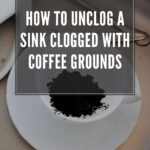As convenient as garbage disposals are, they cannot always handle all the waste that gets washed down into them. Even with proper care, they can slow down your sink’s drainage over time or even make existing clogs worse.
Built-up bacon grease, debris, or organic matter, like coffee grounds, is the most common cause of kitchen sink clogs because of their fine consistency. Thankfully, unclogging your sink is fairly easy to do yourself and usually takes under five minutes using basic tools.
Below are four methods you can use to DIY your own sink repair, as well as a list of steps to take using each method.
What You’ll Need:
- Plunger
- Rubber drain stopper or small towel
- Flashlight
- A long metal rod or screwdriver
- Allen wrench
- Sponge
- Bucket
- Wrench
- Pair of Gloves
- Snake
When you are trying to unclog a sink clogged with coffee grounds, it is best to start by checking the top of the kitchen drain and working your way down. First, you should cover the side of the sink that isn’t clogged. Then, use a plunger to make sure the clog isn’t just below the sink drain.
The Plunger Method
Step 1:
To plunge a kitchen sink blockage, make sure you remove any plugs or drain covers from the clogged side of the sink before you begin.
Step 2:
Then, fill up the clogged side of the sink with water to cover the plunger’s rubber cup. If you have a double sink, seal the non-clogged side with a rubber stopper or a piece of towel.
Step 3:
Next, make sure you hold the plunger handle upright while keeping the clogged drain opening covered by the plunger cup. Then, push the plunger down and pull it back up at least ten times or until the sink begins to drain smoothly.
After you plunge the drain, you will have to check the garbage disposal if your sink is still clogged.
Checking the Kitchen Garbage Disposal
Step 1:
To see if it’s jammed, try turning it on. If you hear a low humming sound, turn off or unplug the garbage disposal.
Step 2:
Then, push the rubber splash guard back and use a flashlight to ensure nothing lodged inside the disposal.
Step 3:
Using a long metal rod, screwdriver, or other pointy tool, push the cutting blades to see if they can spin freely. If they cannot, you will have to insert an Allen wrench at the bottom of the garbage disposal to turn the blades manually. To avoid any unfortunate events, never put your hand into a disposal.
Step 4:
However, if you try to turn on your electric garbage disposal and it does not make any sound, it is probably because an internal breaker got tripped. If that is the case, let your garbage disposal cool off before pushing its reset button. If that fails, it’s time to call a service tech.
If neither of these tricks works and your sink is still clogged, you will need to check your sink’s p-trap.
Checking the P-Trap
Most clogs happen in the sink’s P-trap, which is the U-shaped piece of pipe you see when you look in the cabinet underneath your sink. It traps water to prevent sewage smells and other foul odors from leaking into your house.
If you have already tried plunging your sink and it is still clogged, you will have to remove the sink’s p-trap to clear out the clogged coffee ground.
Step 1:
First, if there is backed-up water in your sink, remove or sponge out as much as possible to help minimize possible spillage when you open your sink’s drain.
Step 2:
Then, find your sink’s p-trap and put a bucket underneath it. This will catch the water that may spill out when you open the p-trap.
Step 3:
Next, loosen the nuts on either end of the sink p-trap that connect it to the drain line. If your p-trap is made of metallic pipe instead of PVC plastic pipes, you will have to loosen the nuts with a pipe wrench. If your p-trap is made of PVC plastic, then you can loosen the nuts with just your hand.
Remember to turn the nuts counterclockwise to loosen them. Lefty loosey, right tighty!
Step 4:
Then, you can pull the p-trap from the drainpipe. Make sure your bucket is in the right spot to catch any water or debris that may come out of the drainpipe or p-trap as you remove it.
Step 5:
Now you can inspect the p-trap for clogs or other obstructions. You can remove any clogs in one of two ways. Either with your hands while wearing rubber gloves or by using something long, pointed, and sturdy like a metal rod or screwdriver.
Step 6:
Then, rinse the p-trap when you are done to remove any remaining obstructions.
Step 7:
Make sure to double-check the pipes that connect the main drain line to the p-trap to ensure there are no other remaining obstructions or blockages.
Step 8:
Then, you can reattach the p-trap to your sink. Just tighten the nuts by rotating them clockwise.
Step 9:
Once you have finished reattaching your p-trap to your sink, turn the sink faucet on to verify that the blockage has been removed and your sink is draining properly. If cleaning out the p-trap doesn’t unclog your sink, you will have to try snaking your drain.
Snaking Method
Step 1:
A drain snake has a long, flexible steel coil that is great for dislodging stoppages, especially in curved pipes. To use it to unclog your sink, just push the end of the coil into the drain opening.
Step 2:
Then turn the handle of the drum holding the rest of the coiled snake.
Step 3:
Keep pushing the plumbing snake in until you feel resistance, then turn it against the blockage.
Step 4:
Once you can feel it moving around freely, recoil the snake by turning the drum handle until the blockage is completely removed.
When in Doubt…
If all else fails, it may be time to call a professional plumber. A bad odor coming from your drain is an indication of a problem. Sometimes, clogs are severe due to leaks, multiple backed-up lines, or extreme grease buildup and may require professional snaking or other professional plumbing services.
If you have tried everything, a professional can look into the more intricate parts of your sink to find the source of the problem.
Frequently Asked Questions
Can I Use Liquid Drain Cleaner to Unclog a Sink Clogged with Coffee Grounds?
Contrary to popular belief, liquid declogging solutions like Draino are bad for the water system and your home’s pipes. A chemical drain cleaner can make a mess, become toxic, and make your clogged sink worse than before you poured anything in it.
Remember, it’s best to avoid using harsh chemicals to unclog your sink.
Is There Any Way to Prevent My Sink From Getting Clogged with Coffee Grounds?
Of course, to avoid coffee ground buildup, the obvious answer is to stop dumping coffee grounds in your sink in the first place. However, you may still end up with some wet grounds in your sink from rinsing or washing dishes. To prevent potential buildup, try following a few simple steps.
Use a strainer in your sink drain to catch food debris from passing through.
Just be sure to clean them out to keep your sink from smelling. You can also pour hot water down the drain once a month to melt any potential grease build-up.
If you are still worried about potential clogs, you can also try pouring ½ cup baking soda and ½ cup vinegar down the drain. Cover and let sit for at least fifteen minutes before pouring boiling water down the drain. This should get rid of any build-up and any funky smells that may be coming from the sink.
Preventing sink clogs can save you the hassle of having to break out all the tools every time your sink starts to act up.
Aren’t Coffee Grounds Supposed to be Good for Drain Pipes?
This is an urban myth! For a long time, people believed wet coffee grounds were abrasive enough to clean the sides of your kitchen sink pipes. However, stubborn coffee grounds can create blockages over time if they become impacted in your sink’s P-trap with other bits and pieces of food.
Even if you think you can get away with washing the occasional bit of coffee grounds down the sink, it can add up over time. This could result in having to make an easy fix or may even require you to hire an expensive repair person.
How Should I Properly Dispose of My Coffee Grounds?
It can seem like more of a hassle, but it is certainly better, in the long run, to dump your coffee grounds in the garbage can. Or, if you are looking for more sustainable, innovative ways of reusing coffee grounds, you could always use them to fertilize your plants.
If you have a compost bin, adding ground coffee to the organic food waste adds nitrogen to your pile. Plants need nitrogen to help them photosynthesize and grow better. Adding coffee grounds to your plant’s soil also helps improve their aeration, water retention, and drainage. Coffee grounds can also help repel pests and insects from your plants or garden.
Snails and slugs do not like crawling over a barrier of coffee grounds. Plus, coffee grounds contain certain compounds such as diterpenes and caffeine that bugs like fruit flies, beetles, and mosquitos, do not like. With coffee grounds around your plants, you can finally garden in peace!

















